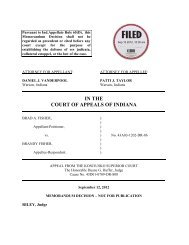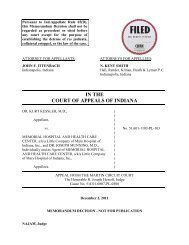Indiana State Health Improvement Plan (I-SHIP) - State of Indiana
Indiana State Health Improvement Plan (I-SHIP) - State of Indiana
Indiana State Health Improvement Plan (I-SHIP) - State of Indiana
You also want an ePaper? Increase the reach of your titles
YUMPU automatically turns print PDFs into web optimized ePapers that Google loves.
Reduce the Burden <strong>of</strong> HIV, STD,<br />
and Viral Hepatitis in <strong>Indiana</strong><br />
The Division <strong>of</strong> HIV, STD, Viral Hepatitis, is comprised <strong>of</strong> several program<br />
areas addressing the prevention and care <strong>of</strong> these infections including: HIV<br />
Prevention, HIV Care and Medical Services, HIV Surveillance, and the STD<br />
Program. Included under these core programs are Communities <strong>of</strong> Color and<br />
Capacity Building, Training and Education, Community <strong>Plan</strong>ning Group,<br />
and Viral Hepatitis Prevention under the HIV Prevention Program. HIV<br />
Care and Medical Services houses the Care Coordination, Medical Services,<br />
Special Populations Support Program, and Consumer and Provider Advisory<br />
Boards. HIV Surveillance serves the Division and the community through<br />
Core Surveillance, Incidence, the Medical Monitoring Project, and the<br />
Advocacy and Responsibility Program. The Division is primarily funded<br />
via federal grants from Centers for Disease Control and Prevention (CDC),<br />
the <strong>Health</strong> Resources and Services Administration (HRSA) and the<br />
Substance Abuse and Mental <strong>Health</strong> Services Administration (SAMSHA)<br />
with some additional funding through the state.<br />
In 2009, the number <strong>of</strong> newly diagnosed persons in <strong>Indiana</strong> was 489,<br />
slightly up from 2008, which had 483 newly diagnosed persons. The<br />
diagnosis rate remained relatively the same in 2009 at 7.7 slightly up from<br />
7.6 per 100,000 people in 2008. The highest rate <strong>of</strong> new diagnosis in 2009<br />
occurred among males between the ages <strong>of</strong> 20 to 24 years <strong>of</strong> age. Males<br />
continue to outrank females more than three times. The male diagnosis rate<br />
<strong>of</strong> 12.1/100,000 in 2009 has increased from a rate <strong>of</strong> 11.9 in 2008. The<br />
female new diagnosis rate remained constant at 3.4/100,000 in 2009 and the<br />
previous year.<br />
More than a third <strong>of</strong> all diagnosed people are Black (41.7%), while about<br />
five out <strong>of</strong> ten people with HIV/AIDS are White (47.9%). The gap between<br />
races continues to shorten as shown by the previous year, 2008 (34.8%<br />
Black vs. 55.9% White). Blacks continue to have a rate (35.3) that is almost<br />
three times the rate <strong>of</strong> Hispanics (12.0), and more than seven times that <strong>of</strong><br />
Whites (4.2). New diagnosis among males is predominant for all racial and<br />
ethnic groups. The rate <strong>of</strong> new diagnosis with HIV/AIDS among Black<br />
males (48.9) is especially high, compared to their Hispanic (20.0) and White<br />
(7.2) counterparts.<br />
By the end <strong>of</strong> December 2009, a total <strong>of</strong> 9,646 persons were living with<br />
HIV/AIDS (PLWHA) in the state <strong>of</strong> <strong>Indiana</strong>, up from 9,282 people by the<br />
end <strong>of</strong> 2008. Geographically, the vast majority <strong>of</strong> people that were<br />
diagnosed in <strong>Indiana</strong> continue to reside in <strong>Indiana</strong> (91.1%). Within the state<br />
<strong>of</strong> <strong>Indiana</strong>, most PLWHA are concentrated in the urban areas <strong>of</strong> the state.<br />
The disease continues to be male dominated, with the number <strong>of</strong> diagnosed<br />
males almost four times higher than that <strong>of</strong> females. The rate <strong>of</strong> infection<br />
was at 247.1 for males and 58.2 for females per 100,000 people <strong>of</strong> the<br />
general population.

















